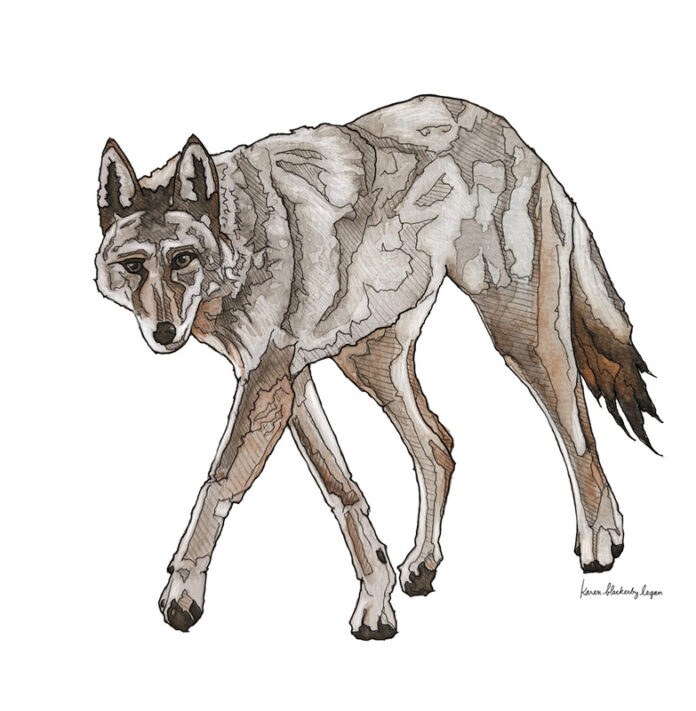Since the first carcass washed up on an Island beach nearly 20 years ago, Islanders have been worrying, speculating, and, of course, arguing about what the presence of coyotes would mean for Martha’s Vineyard. We haven’t faced an apex predator here since Chief Brody and Quint’s fateful victory over Jaws, and we’re understandably wary of the arrival of a new species.
On the one hand, coyotes could help some imbalances in our ecosystem — their diet consists mainly of small mammals, like rats and rabbits, as well as the young of larger animals, like turkeys and deer. All of these are plentiful on the Island, and in some areas considered nuisances. Surely a natural predator would be preferable to human interventions — poisoning rats is dangerous and often deadly to birds of prey who ingest them. But just as other species thrive here a little too well for our liking, so could coyotes. We’ve all heard stories and read news reports from the mainland of coyotes attacking pets and decimating livestock — a particular problem for an Island with a strong agricultural presence.
Tisbury Animal Control Officer Heather Maciel shares the concern of the farming community, and she predicts the Island will look a lot different if the population explodes as it has in other areas in Massachusetts.
“People aren’t going to be able to free-range their chickens anymore,” she speculates, “and they’re going to need to rethink lambing season altogether.” Island farmers are a practical group. They are used to protecting their land and animals from all sorts of dangers — disease, drought, hungry wildlife with Olympic-level jumping and digging abilities. And when faced with a new threat, they are quick to reach out for help from those with more experience.
This past winter, Heather invited Dan Proulx, a problem animal control agent from Swampscott, Mass., to speak to Islanders about the interaction between coyotes and humans. In addition to tips on keeping pets and livestock safe, Dan encouraged Islanders to work together to come up with a plan that works for our unique community. Since then, a group of Islanders has been meeting — representatives from the hunting and farming communities, as well as naturalists and law enforcement officers. Heather has been coordinating these meetings and is impressed by their success in gathering information. Hunters, who are typically very secretive about their hunting spots, are sharing footage from trail cameras they have all over the Island. Island naturalist Gus Ben David has identified at least six different individuals, and numerous dens, in photos and videos from Aquinnah to Edgartown. Not a huge number, but coyotes are aloof creatures, and there are surely more who are evading notice.
This group continues to meet to exchange information and is in the process of developing methods of sharing what they learn. The coyotes are currently doing what we want them to do- keeping to themselves. There have been very few reports of domestic animals being disturbed. For now, the most sensible course of action is to encourage them to keep their distance. There are things farmers and landowners can do themselves, like securing fences and changing feeding practices. But if their neighbors are leaving their trash cans unfastened, or worse — actively feeding them, coyotes will learn to associate humans with food, and consequently teach their young to do the same. On the other hand, if we “haze” coyotes — make lots of noise, wave our arms, throw things in their general direction — whenever they approach us or our land, they are more likely to remain afraid of us. If they continue to pass that particular survival skill on to subsequent generations, we’ll have a much easier time coexisting with them as their numbers grow.
Group members are confident that Islanders can work together to prevent a major problem. We have had the luxury of watching coyotes spread across the state and can benefit from seeing what hasn’t worked in other areas. Sure, there are jokes about packages from the Acme corporation appearing and hiring a team of roadrunners to help out. But for the most part, Islanders are taking the threat seriously. We are prone to heated discussions about sports fields and school renovation projects, but we unite around so much more. We value our access to open spaces, lush forests, and local eggs and lamb. We take pride in supporting one another and jump at the chance to band together in the face of adversity. Even our less desirable traits may be the most helpful in fighting this particular fight. Our long and complicated relationship with visitors has left us with a healthy suspicion of off-Islanders. Despite our ability to be polite, even welcoming, to tourists who stop by for a quick visit, those who try to establish themselves here have a tougher time. And if those “washashores” think they can barge in and hijack our closely guarded Island traditions, well, we have a way of making them feel most unwelcome.


